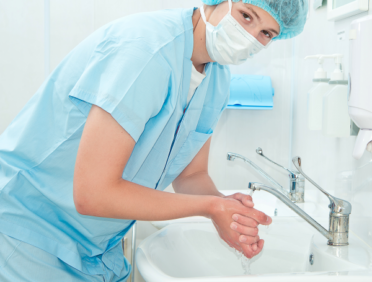The Food Hygiene Rating Scheme (FHRS) exists to provide people with the necessary knowledge they need to decide where to eat. As a business, you will rely on a high rating on the scheme to successfully attract customers.
You will probably recognise the rating by the numbers that you see on the windows or the door or the interior of a restaurant. However, understanding what the numbers mean, how the rating is decided, what the benefits of the rating are, and other information is vital for a business.
Let’s take a proper look at the food hygiene rating scheme, and provide key information that will help any business successfully attract more customers.
What is the Food Hygiene Rating Scheme?
So, what is the food hygiene rating scheme, and why is it so important?
The food hygiene rating scheme is an initiative run by the Food Standards Agency (FSA) and your local authority. The scheme is designed to provide customers with critical information about the hygiene standards that food premises demonstrate at the time they are inspected by the food safety officer on behalf of the local authority.
Every restaurant or food premises are required to have a food hygiene rating. It is a legal requirement to sell food to the public. You also have a legal requirement to display your food hygiene rating where it can be seen by customers.
The purpose of the food hygiene rating scheme is to provide the public with the information required to make an informed decision about the place they choose to purchase food. The inspections use legal requirements laid down by the Food Standards Agency to measure hygiene, the equipment that a business will have for food preparation, and perform an evaluation of the processes involved in preparing and selling food.
To put it another way, if you own a restaurant or a takeaway, and you want to sell to the public, then you have to get a food hygiene rating. It’s a legal requirement, but every aspect of your business, from the way that you store food to preparing food to finally selling food, will be evaluated.
What Does the Food Hygiene Rating Scheme Cover?
The food hygiene rating scheme is designed to cover a broad range of aspects relating to preparing and selling food. Every part of your business will be evaluated as part of this rating.
Generally speaking, the food hygiene rating scheme is broken up into three key areas.
The first part of the scheme concerns hygienic food handling. This portion of the scheme refers to the preparation, cooking, and reheating/cooling of food. The way that you store food and deal with excess food is also covered.
The second part of the scheme is all about the physical condition of the property where the food is cooked. So, if you are using premises or facilities, it will be evaluated as part of the inspection. Areas of assessment will include the physical layout, lighting, what cooking implements that you use, whether or not the building has adequate ventilation, suitable health and safety regulations, and pest control solutions.
Finally, the third part of the rating scheme is all about food safety management. This part of the scheme is focused on you and your staff. This will include whether or not your staff are trained to safely handle and prepare food, whether you are complying with health and safety codes, food safety codes, personal hygiene codes, and your internal processes involved in day-to-day operations. You will be expected to provide information regarding risk assessments and to have a record of staff training.
How the Food Hygiene Rating Scheme Works
As previously mentioned, the food hygiene rating scheme is broken down into three categories. When you register as a business and wish to begin publicly trading and selling food, you will have to apply to your local authority to have a food hygiene rating assessment conducted.
A member of the local authority will arrange to visit your premises and perform an evaluation. They will provide you with a food hygiene rating based on the criteria and a number between 1 and 5. This number will correspond to a certain amount of points and will be awarded to you by the local authority. We will talk more about how the rating scheme works later on.
Benefits of the Food Hygiene Rating Scheme
There are quite a few benefits to getting the food hygiene rating scheme sorted for your business. Specifically, you want to try and aim for a higher rating to improve your business and your reputation.
A higher rating is something you can display and use as a way to secure more customers. It’s all about the confidence factor – customers respond to higher ratings, and they feel more comfortable purchasing from you.
Higher ratings also mean that your involvement with the local authority is minimal. Generally speaking, your local authority will be content to let you operate in peace if you have a higher rating. Low-rated businesses get more inspections.
Other benefits to having a high food hygiene rating can include a reduced risk of being sued because your business has given someone food poisoning. You will also cut down the risk of being fined or penalised for a low rating.
A five-star rating can also be good for helping you stand out. Businesses need whatever edge they can get when trying to compete with other restaurants and takeaways, so having this rating will allow you to bring more customers to the door.
Exemptions of the Food Hygiene Rating Scheme
It is important to realise that there are certain exemptions to the food hygiene rating scheme. These types of businesses will be inspected by the food safety officer sent by the local authority but will not be given a rating.
The first group of businesses that are considered to be low or minimal risk to public health. So examples of this include things like chemists, newsagents, or visitor centres which are selling pre-wrapped goods that require no preparation on the premises. If the building does not require refrigeration services, it will not be given a rating.
The other type of business which is exempt from a food hygiene rating is childminders or any business which offers caring services in the home.
Breakdown of the Rating Scale
To finish off, let’s take a look at the rating scale in full and break it down. It’s important to understand that the rating scale works out by receiving both an individual number and then a certain number of points. This will become clear as each rating on the scale is discussed.
Rating = 0
If your business receives a food hygiene rating of 0, that means that urgent improvement is required. If you receive a zero, your business has scored more than 50 points, which means that the inspector found many issues. The more points your business has, the greater the number of issues.
A good example of this might be if the business fails to keep proper records of safety systems and staff training or has food hygiene violations that could put public health at risk.
Rating = 1
If your business receives a food hygiene rating of 1, this means that significant improvements are required. If you score between 45 and 50 points, that is the equivalent of a 1. Common explanations for this include multiple breaches in food hygiene codes and a lack of staff training.
Rating = 2
If your business receives a score of 2, that means that some improvements are necessary. A 2 will be given to any business with scores between 35 and 40. Good examples of a 2 rating include issues with handling practices or facilities that need upgrades/changes.
Rating = 3
If you receive a rating of 3, that means that your business has been found to be satisfactory. Scoring between 25 and 30 points is the benchmark for 3 and considered to be the minimum requirement for good health and safety. However, there is room to improve, even if the issues don’t immediately pose a threat to public health.
Rating = 4
If your business receives a food hygiene rating of 4, that means it has been marked as a good business. Your assessment scored less than 20 points, which has earned you a 4 rating. This translates to your business having good, compliant health and safety systems/hygiene practices. There are a few minor areas for improvement, but a 4 is a perfectly commendable rating and will be valuable for your business.
Rating = 5
Finally, the highest score that you can receive is a food hygiene rating of 5. This means that you’ve scored between 0 and 15 on your assessment, and this reflects the highest standard of food hygiene and health and safety that a business can earn.
Receiving a rating of 5 is considered to be the goal for most businesses. This looks incredibly attractive for your restaurant or takeaway and helps to reassure customers that you are committed to hygiene and their health and safety.
To download a .pdf of this blog, please click here












